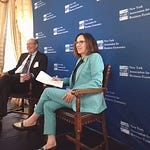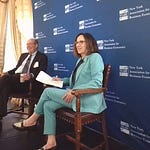Ahyan Kose and I have been talking about the global forces driving inflation and central banks since we first met back in the summer of 2024, him as as deputy chief economist at the World Bank, me as editor in chief of Central Bank Central.
Back then inflation had fallen from an eye-popping 9% in the U.S. down to about 3% on the headline number, aided by falling commodity prices, a trend he applauded but was not ready to conclude would continue. In particular he was looking at Midde East tensions that could hit oil logistics, cut production, and boost prices.
Fast forward to now. Tariff turbulence around the world is weakening global demand and pulling the rug out from under commodity prices as the World Bank’s 2025 outlook report highlights. In fact, Ayhan and his team are forecasting an exceptional drop in commodity prices now.
Ayhan is betting that in the coming months weaker commodity prices will aid in abroader move to cut rates by major central banks like the Federal Reserve, the European Central bank, and the Bank of England who he predics will cut rates “multiple times…by the end of the year.”
So dive in and hear what he says to say. If you are eager to see central bank rate cuts, you will like what to see what he has to say and the commodity forecasts that help back it up.
Weak commodity prices from weak demand 00:01:01.180
It's great to be with you again. There are multiple forces in play with this weakness. We see in commodity markets and overall volatility. First, obviously, the global economy is slowing and slowing at a rapid pace in an environment we see historically high uncertainty, policy, uncertainty and historically low confidence. So when you combine these 3, that means demand is slowing, and in all likelihood demand is going to slow in major commodity importing economies, including China, and that pushes, you know, prices down and create considerable volatility in commodity markets, as we saw in April.
Recession pummels commodity prices 00:01:50.730
Now, the important point is that when you look at what happened in the past, when there were these periods of sharp downturns in the global economy, commodity prices decline in the next 6 months give and take 20 to 25%.: We are not thinking that we are there yet, but of course the pace of Slowdown has been quite rapid. Second important point is that when you look at the supply dynamics there is ample supply, especially in the context of oil.
Oil is a huge positive for the inflation outlook 00:02:23.750
Recent developments coincided with this announcement from Opec, plus that they are going to bring more oil to the markets. So give and take. The Opec plus has about 78 million barrels per day extra capacity. And if push comes to shove in all likelihood, they are going to say we need to protect our market share, and they might just, you know, bring more oil to the market, and that also pushes down the prices. One more thing I must add, there are some structural factors to think about over the kind of the medium term we are seeing. Oil intensity of consumption has been declining, you know, last year, in 2024, about 40% of cars sold in China. They were hybrid or ev vehicles. So the decline in oil demand is there. There's still, you know, the growth, but that growth is slowing.
This is not a supply story- 00:04:03.090
Obviously, this is not a you know, supply story. There is no, you know, sudden, basically surge of supply. The economies are slowing. We are seeing major tensions between key economies in the world, and that is reflected in financial markets and overall activity. If you are an energy producer, if you are a producer of metals, this is a net negative. When you think about declining prices. In fact, for these economies, what we know from the past experience, their primary balances deteriorate and deteriorate rapidly, depending on the decline in the good, the commodity.
A mixed bag of effects: good, bad, and ugly 00:04:54.530
Some of these, you know, developing economies are commodity importers for them. This could be a boon, you know. Think about countries like Turkey, India, Pakistan, that can help in terms of their current account balances. But we need to put this in context when you put it in context. two thirds of emerging and developing economies are commodity exporters, and they will struggle in an environment we see, you know, declining prices along with, of course, weaker global growth. And we will also in all likelihood see much weaker trade growth this year.
Expected price action is weak 00:06:05.400
So the 1st observation with respect to prices, you know, we have a World Bank commodity price index. This year. We are expecting a 12% decline. and that will be followed according to our projections, another 5% decline next year. So the decline is broad based. We think that more than 50% of commodities. We follow about 46 prices, we'll see declines about 10% more than 10% this year.
Volatility of historic proportions in commodities 00:06:39.280
Now, the challenge is that. How basically these recent developments, in a sense, a kind of a follow up what we have seen before this decade, the 2020’s are turning out to be the most volatile we have seen since the 1970’s in terms of commodity markets. That might not be a basic surprise. Given that, you know, we had the pandemic and then Russian invasion of Ukraine. We basically had this inflation surge. And then we saw the sharpest tightening cycle in a generation. All of these things add up. And now we have these major trade tensions and historically high policy uncertainty.
Prices will settle lower 00:07:59.400
These price developments imply that the type of boom commodity markets saw after the pandemic are coming to an end. So in real terms, prices are going to come down below the levels of 2015-2019 averages, and of course, that is also related to volatility. I mentioned a few minutes ago.
Gold should surge then stabilize- 00:09:18.190
All of this combined increase demand for gold, and this year we are expecting gold price to break another record after, you know, breaking records for the past several years, and by the end of you know, this year we are thinking that the gold price is going to be around 150% higher than what we saw over the period 2015 – 2019 average. Now, of course, the central banks also continue buying gold in their reserve accumulation. So the challenge is that as hopefully the uncertainty comes down, gold prices will also stabilize, and we think that that will happen next year.
Central bank rate cuts expected in challenging times 00:12:23.660
Now, that's a huge challenge, because especially for inflation targeters and those central banks with dual mandates in an environment, you see weakening growth in all likelihood weakening labor markets, and in some cases inflationary pressures going up. That's certainly the case for the Us. Economy. They need to wait and see and then react. But the market expectations suggest the major central banks, the Fed and Bank of England and European Central Bank. They will cut interest rates multiple times. By the end of this year.
Emerging economies are trading more with each other- 00:14:49.880
Global trading system is under threat and that has huge implications for emerging and developing economies. But these economies, you know, are not the economies of the 2 thousands. They trade a lot with each other much more than what they used to do. And when you look at the growth of trade in these economies, the growth of trade with other emerging developing economies is much faster than the growth of trade with advanced economies. So what is important for them going forward is to build on this within emerging, developing economy trade and basically first embrace more integration, not less be aggressive in terms of. you know, reducing trade barriers and reduce trade barriers universally, and of course, sign trade agreements, if possible.
Critical roles played by IMF and World Bank 00:19:42.370
Over decades. And I think that these organizations, especially the world trade organization, has carried the flag and has the, you know, the incredible potential to do so in this highly charged environment. And of course, World Bank Imf, when it comes to policy advice when it comes to facilitating more trade play, critical roles.
AYHAN KOSE
Ayhan Kose is the Deputy Chief Economist of the World Bank Group and Director of the Prospects Group. He is a member of the Chief Economist’s leadership team overseeing the Bank’s analytical work, and policy and operational advice. He also leads the Bank’s work on the global macroeconomic outlook, financial flows, and commodity markets. Under his management, the Prospects Group produces the Bank’s flagship reports Global Economic Prospects and Commodity Markets Outlook, in addition to other policy and analytical publications. Prior to joining the World Bank, he was Assistant to the Director of the Research Department and Deputy Chief of the Multilateral Surveillance Division in the International Monetary Fund (IMF). He served in a wide range of roles supporting IMF’s analytical, policy, and operational work.
Mr. Kose has written extensively on international macroeconomics and finance. His articles have been published in leading academic journals, including the American Economic Review, International Economic Review, Journal of Monetary Economics, Journal of International Economics, Journal of Development Economics, and many others. His latest book, Falling Long-Term Growth Prospects (co-edited), examines the evolution of global potential growth and its underlying drivers. His recent policy work focuses on global inflation, debt challenges, and business cycles.
Mr. Kose is a Nonresident Senior Fellow at the Brookings Institution, a Dean’s Fellow at the University of Virginia’s Darden School of Business, a Research Fellow at the Center for Economic Policy Research (CEPR), and a Research Associate at the Center for Applied Macroeconomics (CAMA). He taught at the University of Chicago’s Booth School of Business, INSEAD, and Brandeis International Business School. He has a Ph.D. in economics from the Tippie College of Business at the University of Iowa and a B.S. in industrial engineering from Bilkent University. A native of Turkey, Mr. Kose was born and raised in Istanbul.














Share this post